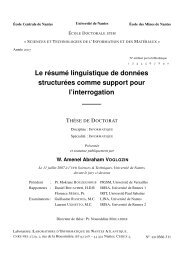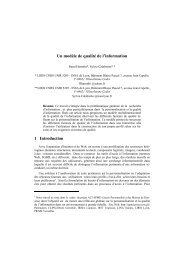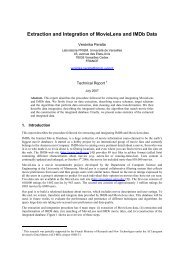Create successful ePaper yourself
Turn your PDF publications into a flip-book with our unique Google optimized e-Paper software.
62 J Intell Inf Syst (2006) 26: 59–73quantifier and R and S are summarizers (linguistic terms). One can obtain statements like“most people in DB are tall” or“most tall people in DB are heavy”.Predicates (i.e. summaries) and linguistic terms are fuzzy sets in the expression that representsthe selection condition. The expression is evaluated for each tuple and the associatedtruth values are later used to obtain a truth value for the <strong>summary</strong>. SummarySQL is used todetermine whether, or to what extent, a statement is true. It can also be used to search forfuzzy rules.2.4. FSQLFSQL (Galindo, 1998) is an extension <strong>of</strong> SQL in which all SQL expressions are valid.The language is available through a client-server architecture in which the server s<strong>of</strong>twareaccesses an Oracle <strong>database</strong>. SQL is extended to allow flexible conditions using linguisticlabels, fuzzy comparison operators, fuzzy constants and many other fuzzy constructs. Forinstance, a fuzzy quantifier can be specified in the language’s metaknowledge base by givingthe four values that define a trapezoidal possibility distribution. Each condition in a querycan be given a threshold that sets the minimum satisfaction degree for the condition. FSQLdoes not limit flexibility to the SELECT clause. INSERT, UPDATE and DELETE are alsosupported.FSQL is remarkable in two aspects. First, the wide variety <strong>of</strong> flexible constructs that areavailable and second, it is one <strong>of</strong> the very few, it not the only, fuzzy extensions <strong>of</strong> SQLimplemented over an existing <strong>database</strong> management system.3. <strong>Querying</strong> the SaintEtiQ summariesThe targeting <strong>of</strong> <strong>database</strong> records in flexible queries may lead to prohibitive response timeswhen a large number <strong>of</strong> records is involved, or when subqueries are employed. Waiting foran answer for a long time is frustrating, particularly when the query fails (that is, it has nomatching record in the dataset).Database summaries <strong>of</strong>fer a means for significantly reducing the volume <strong>of</strong> input for processesthat require an access to the <strong>database</strong>. The response time benefits from the downsizing.Furthermore, for this querying process, performance does not depend on specific combinations<strong>of</strong> attributes, i.e., whether the attributes are indexed or not, since these summaries aregeneral indexes for the underlying data (Raschia, 2001).When querying the summaries, the response time gain is made clearly at the expense<strong>of</strong> a loss <strong>of</strong> precision in the answer. This is <strong>of</strong> no importance when only a rough answer isrequired. This can be the case for instance when querying a medical <strong>database</strong> for anonymous,statistical information. Indeed, precise information can violate medical confidentiality. Theloss <strong>of</strong> precision is also <strong>of</strong> no importance when a request only aims at determining the absence<strong>of</strong> information in a <strong>database</strong>. As already said, this is the case when one wants to know if a<strong>database</strong> is likely to answer the query.When more details about the tuples are needed, querying the summaries is a first step only:the entire set <strong>of</strong> relevant tuples can be easily retrieved from the answer summaries. The queryingmechanism remains efficient, and there is no loss <strong>of</strong> precision in the answer. However,the loss is in the querying language expressiveness. At present, only the linguistic variablesused to build the summaries hierarchy can be used in the expression <strong>of</strong> the queries. Moreover,as the generated summaries can be considered as one table in the <strong>database</strong> relational model,Springer







